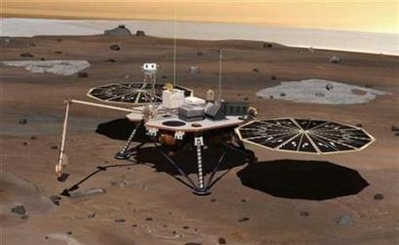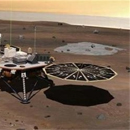Phoenix Spacecraft on Track for Mars Landing
Space.com
May 12, 2008
WASHINGTON - With just 12 days to go until its Mars arrival, NASA's Phoenix lander is functioning well and on course to be the first mission to land in the frigid, arctic regions of the red planet, NASA officials said today.
A planned maneuver to adjust Phoenix's course was canceled last Saturday because the spacecraft is on track for its May 25 landing, said Barry Goldstein, Phoenix project manager at NASA's Jet Propulsion Laboratory in Pasadena, Calif. Another maneuver is set for this coming Saturday.
NASA also released enhanced images of Phoenix's landing site, located at 68 degrees north latitude, 233 degrees east longitude in Vastitas Borealis, the northern arctic planes of Mars. This latitude corresponds to northern Canada, just below the Arctic sea, said Phoenix principal investigator Peter Smith of the University of Arizona, Tucson.
Below the surface layer of dust in these plains lies a layer of water ice mixed with sand and dust. During its three-month mission, Phoenix will use its 7.7-foot (2.3-meter) robotic arm to dig up samples of this dirty ice and analyze it with onboard science instruments to shed light on the history of water in the Martian arctic and see if the icy soil could support life.
In these polar regions, "there's a very large abundance of water," Smith said. "We expect a tremendous abundance of ice in the landing site."
Phoenix is picking up where its ill-fated brother, the Mars Polar Lander (MPL), left off after it failed to make a safe landing in at the Martian south pole in 1999. Though it will use nearly the same landing strategy, Phoenix contains different instrumentation to explore the planet.
"Phoenix is truly an appropriate name for this lander as it has risen from two Mars failures," said Ed Weiler, associate administrator of NASA's Science Mission Directorate.
The $420-million mission launched last August and has traveled about 422 million miles (679 million km) to reach our red-hued neighbor. The lander currently has about 10 million miles (about 16 million km) left to go before setting down in the martian arctic.
Phoenix is slated to touchdown at 7:53 p.m. EDT (2353 GMT) on May 25. Unlike its rover cousins Spirit and Opportunity (currently exploring closer to Mars' equator), Phoenix will not use airbags to land. Instead, it will rely on a set of rocket thrusters that will fire in slow pulses to slow the craft down during its descent, similar to the design for the MPL.
The last successful use of this landing approach was 32 years ago with NASA's Viking landers in the 1970s.
Mission scientists said that the known problems with the MPL have been addressed and fixed, along with several other problems engineers later identified, though they cautioned that that doesn't rule out unforeseen issues.
"Although we've fixed all the known issues from the MPL, remember, there is always the unknown unknown," Weiler said.
Ray Arvidson, chairman of the Phoenix landing site working group, said that the team at the University of Arizona, Tucson, where the new lander's operations will be based, will be taking the instruments through their paces in the critical first days after landing.
"It's all scripted," said Arvidson, adding that Phoenix scientists and engineers have prepared for a number of contingencies after landing.
Such issues may include problems with instruments, power failures and obstacles such as a rock lying in the way of the deployment of the solar arrays that will power the lander throughout its three-month mission, until the sun sets at the end of the martian summer.
"The risks will certainly be there, but the rewards will absolutely pay off," said Doug McCuistion, director of the Mars Exploration Program. The Phoenix mission's potential wealth of information about martian soil, the history of weather of Mars, as well as the state of water in the planet's current climate outweigh the risks of another failure, he added.
NASA's Mars Reconnaissance Orbiter and Mars Odyssey have been repositioned to track descent of Phoenix and relay communications between the lander and Earth during its "seven minutes of terror" falling through the Martian atmosphere, as Goldstein put it, and once the spacecraft is settled on the planet.





 Share your thoughts in the Forum
Share your thoughts in the Forum
